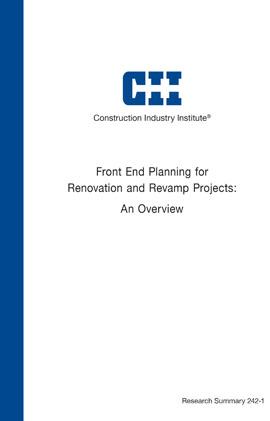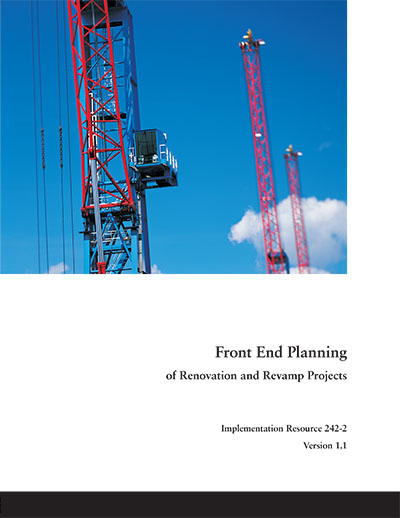
Front End Planning for Renovation and Revamp Projects: An Overview
Front end planning (FEP) is arguably the single most important process in the capital project life cycle. Known by many terms such as pre-project planning, front end loading, sanctioning process, programming/schematic design/design development, and others, front end planning creates the critical underpinning to any capital project. Front end planning is focused on creating a strong, early link between the business or mission need, project strategy, scope, cost, and schedule and maintaining that link unbroken throughout the project life. It has been considered a CII Best Practice for many years.
This summary focuses on recent CII research that shows the importance of the front end planning process with regard to renovation and revamp (R&R) projects. R&R projects are truly unique in terms of their singular planning aspects and risk exposure. A subset of R&R projects is shutdown/turnaround/outage (STO) projects, which were investigated as an important component of this work.
In this summary, results from 25 case study evaluations are presented from projects worth over $1.4 billion. Additionally, statistical analysis of project data from the CII Benchmarking & Metrics database in excess of $23 billion focusing on front end planning effectiveness on R&R projects is discussed. Results are also presented from four workshops focused on front end planning related STO projects, involving 67 industry participants from 39 organizations.
Data from the CII membership show that approximately 30 percent of expenditures on capital projects are focused on R&R work. Unique characteristics of R&R projects include:
- Safety and security issues of work force interfacing with existing operations
- Unforeseen site conditions more prominent
- Scope definition, estimating the amount of work more difficult
- Scheduling intensity, higher in many cases
- Shutdowns and maintenance work interface on many projects
- Greater need to interface with operations/tenants, maintenance, and construction personnel
- Additional schedule constraints occur due to operational interfaces
- Different funding sources, including both local capital and non-capital funds.
In addition to traditional front end planning issues for greenfield projects, planning teams must be concerned with the following issues as they effectively plan for R&R work:
- Stakeholder identification including existing operations personnel and/or tenants along with alignment and teambuilding of larger list of participants
- Defined front end planning process followed even if the project is small
- Adequate scope definition, including use of tools such as the Project Definition Rating Index (PDRI) and others
- Choosing the right contracting strategy to address the unique project drivers of R&R work
- Thorough investigation of existing conditions, including use of technology and field surveys
- Assessing the impact of labor and material availability in terms of the R&R work, especially for STOs
- Providing leadership and experience in key planning disciplines, particularly regarding issues unique to the R&R location and type of work
- Considering alternative execution practices, such as modularization and prefabrication during planning to enhance R&R project performance.
As part of this work, the existing PDRI tools that CII has for building and industrial projects were revised to reflect unique issues related to R&R projects. In addition, the research team developed a new tool: STAR (Shutdown Turnaround Alignment Review) for addressing STO projects during front end planning. The team also developed Project Condition Investigation (PCI) cards outlining tools and techniques to enhance front end planning risk management. This summary provides an overview of tools and management practices that can be followed to help effectively plan for the issues outlined above.
A stakeholder is defined as any person who has influence on the course of an event and/or a material interest in that event’s outcome. The number of stakeholders for R&R projects is generally larger than for Greenfield projects.
Clear definition of what is in and what is out of scope of a project should be made early in the Front End Planning (FEP) process. It is extremely important to have all key stakeholders involved in project decisions, but even more important to have alignment between these stakeholders so that the parameters of the project can be agreed upon. For R&R projects in particular, individuals involved may be tempted to increase scope to fix issues with the existing facility as part of the R&R project when these might be more appropriately dealt with under the facility budget. (RS242-1, p. 16)
CII defines alignment as the condition where appropriate project participants are working within acceptable tolerances to develop and meet a uniformly defined and understood set of project objectives. For R&R projects, there are increased requirements to interface with local engineering, operations, and maintenance staff, making alignment more difficult. Key site stakeholders can be distracted by other duties during project planning, but later may invoke unexpected requirements during project execution. All key stakeholders need to feel involved as contributing members of the project team and participate in front end planning to help ensure project success, alignment around project plan and goals.
One way to achieve alignment on a project is through teambuilding. Teambuilding is a technique used on projects to establish trust and cultivate relationships among stakeholders. This is especially valuable when the project team is new or from outside the facility where the R&R project will take place. (RS242-1, p. 17)
The scope of a project has a large impact on cost and schedule. A well-defined scope for R&R projects should include early identification of project elements and risk factors so that project team members can develop mitigation strategies. Of special importance for R&R projects is the identification of what scope items are not in scope of the project, as there can be a tendency during project execution of such projects to inappropriately allocate non-value or maintenance items into the project.
Project drivers need to be clearly defined and understood by the project team in order to choose the proper contract strategy. A project driver can be defined as the why of project execution. Project drivers, which are normally identified in the front end planning phase of the project life cycle, can affect a R&R project in terms of a specific design solution, funding, and contract strategy. (RS242-1, p. 19)



